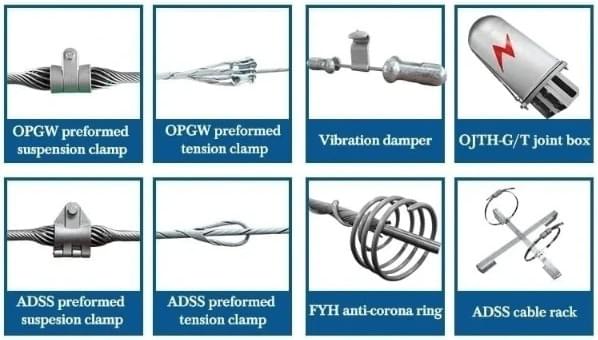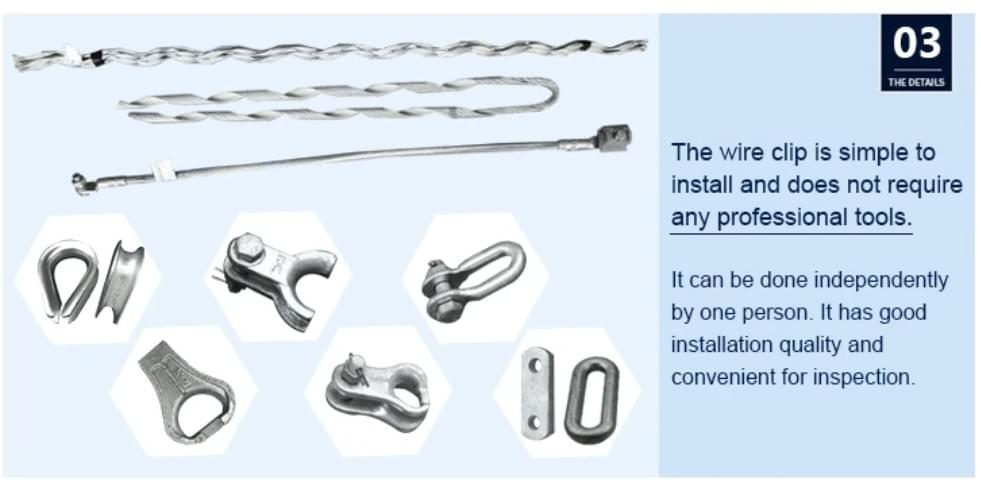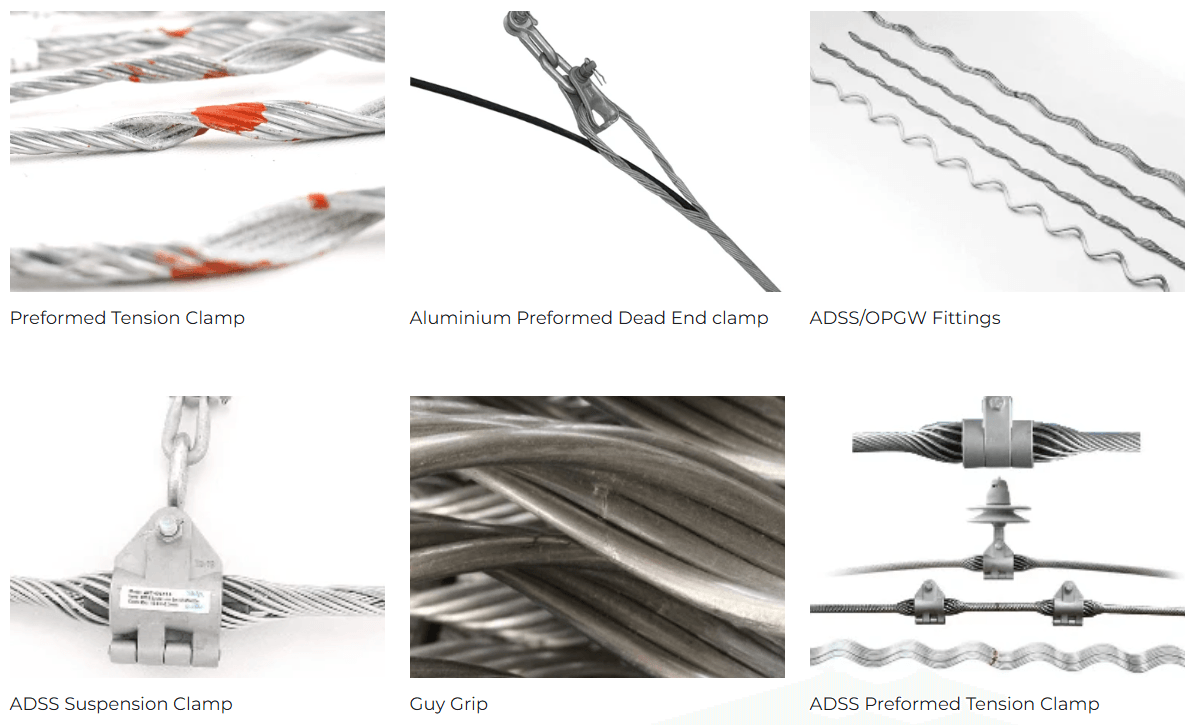Introduction

Understanding Transmission Suspension Clamps
Transmission suspension clamps are designed to support overhead cables and ensure they remain secure during various environmental conditions. They play a pivotal role in distributing weight evenly while minimizing stress on the cables themselves. Without these clamps, cables could sag or even detach, leading to costly outages or dangerous situations.
Key Functions of Suspension Clamps
So, what is the purpose of a suspension clamp? Primarily, these devices hold cables in place while allowing for some movement due to thermal expansion or wind pressure. They also help manage cable tension and prevent excessive wear over time, making them indispensable for any power transmission system.
Importance of Choosing the Right Clamp
Selecting the appropriate suspension clamp is vital for both performance and safety reasons. The wrong choice can lead to issues such as cable damage or equipment failure—what are the side effects of clamp suspension? By understanding your specific needs and applications, you can avoid common pitfalls and ensure a reliable setup that meets industry standards.
What is the Purpose of a Suspension Clamp?

Suspension clamps play a vital role in the realm of power transmission, serving as the unsung heroes that keep everything in place. These components are designed to support and secure overhead cables, ensuring they maintain their integrity and function effectively. But what is the purpose of a suspension clamp? In essence, they provide stability, prevent sagging, and protect cables from environmental factors.
Basic Functionality of Transmission Suspension Clamps
The basic functionality of transmission suspension clamps revolves around their ability to hold cables securely in place while allowing for some movement due to thermal expansion or wind pressure. These clamps are engineered to absorb stress without compromising the cable's integrity, thus preventing potential damage over time. By distributing weight evenly across the structure, they ensure that power lines can operate efficiently and safely.
Applications in Power Transmission
Transmission suspension clamps find their primary application in power transmission systems where high-voltage cables need reliable support. Whether it’s on utility poles or within substations, these clamps help maintain proper tension and alignment of conductors during operation. Their versatility extends beyond just electrical applications; they're also used in telecommunications and railway systems to manage various types of cabling.
Benefits for Cable Management
When it comes to cable management, using a transmission suspension clamp offers several benefits that can't be overlooked. For starters, they help reduce clutter by organizing cables neatly along designated pathways, making maintenance much easier down the line. Additionally, these clamps minimize wear and tear on cables by preventing unnecessary movement or friction against other surfaces—an essential factor when considering what are the side effects of clamp suspension? Ultimately, effective cable management leads to improved safety and longevity for your electrical systems.
Recognizing the Side Effects of Clamp Suspension

When it comes to using a transmission suspension clamp, understanding its side effects is crucial for ensuring optimal performance and safety. While these clamps serve essential functions in power transmission and cable management, they can also inadvertently affect cable integrity and equipment reliability. In this section, we will explore the impact of clamp suspension on cables, potential risks to equipment, and common installation mistakes that could lead to complications.
Impact on Cable Integrity
One of the primary concerns regarding the use of a transmission suspension clamp is its impact on cable integrity. If not properly installed or selected, these clamps can exert excessive pressure on cables, leading to wear and tear over time. Additionally, improper alignment during installation may cause stress points that compromise the overall durability of the cables.
Furthermore, when evaluating what is the purpose of a suspension clamp, it’s essential to consider how it interacts with different types of cables. Some materials may be more prone to damage than others when subjected to clamp pressure. Thus, selecting a suitable clamp is vital for maintaining cable integrity and preventing premature failure.
Potential Risks to Equipment
The potential risks associated with improper use of suspension clamps extend beyond just cables; they can also pose significant threats to surrounding equipment. For instance, if a transmission suspension clamp fails or loosens due to poor installation practices, it could lead to misalignment or even complete disconnection of electrical systems. This not only disrupts operations but can also cause costly damage.
Moreover, understanding what are the side effects of clamp suspension helps in identifying scenarios where equipment might be at risk due to inadequate support or protection from environmental factors like wind or ice load. Regular inspections are necessary as part of best practices for secure usage—this ensures that any signs of wear or malfunction are addressed promptly before they escalate into more severe issues.
Common Installation Mistakes
Despite their straightforward design, many users encounter common installation mistakes when employing transmission suspension clamps that could lead to adverse outcomes. One frequent error is overlooking manufacturer guidelines regarding torque specifications; over-tightening can cause irreversible damage while under-tightening may result in instability during operation.
Another pitfall occurs when users fail to account for environmental factors such as temperature fluctuations or mechanical vibrations during installation—neglecting these elements can significantly undermine what is clamp suspension used for in infants as well as other applications requiring stability and safety measures. To ensure effective usage and mitigate risks associated with improper installations, it's crucial for operators to adopt best practices tailored specifically for their unique situations.
How Do You Use Suspension Clamps?

Using a transmission suspension clamp might seem straightforward, but it involves a few essential steps to ensure optimal performance and safety. Understanding how to effectively use these clamps can prevent issues related to cable integrity and equipment risks, which are often raised when discussing the side effects of clamp suspension. Whether you're working on power transmission or even pediatric applications, knowing how to install and use these clamps is crucial.
Step-by-Step Installation Guide
To kick things off with your transmission suspension clamp, start by gathering all necessary components and ensuring you have the right type of clamp for your specific application. Begin by positioning the clamp around the cable at the desired location; this is where you'll secure it for optimal support. Next, tighten the clamp using appropriate tools until it's snug but not overly tight—this will help avoid damaging the cable.
After securing the initial position, double-check that everything is aligned correctly before finalizing installation. It's also wise to inspect surrounding areas for any potential hazards that could affect your setup after installation is complete. Remember, proper installation plays a significant role in answering questions like What is the purpose of a suspension clamp?—which ultimately promotes stability and safety in power transmission.
Best Practices for Secure Usage
When using suspension clamps, following best practices can enhance their effectiveness and longevity. Always ensure that the clamps used are rated for the specific load they will bear; this prevents undue stress on both cables and equipment involved in power transmission applications. Regularly inspect installed clamps for wear or damage; proactive maintenance can mitigate potential risks associated with common installation mistakes.
Moreover, consider environmental factors such as temperature fluctuations or exposure to moisture that could impact your clamps' performance over time. This awareness ties back into understanding what are the side effects of clamp suspension; neglecting these factors might lead to premature failure or safety hazards down the line. By adhering to best practices, you not only secure effective usage but also prolong their lifespan.
Tools Required for Effective Installation
To facilitate an efficient installation process of your transmission suspension clamp, having the right tools at hand is non-negotiable. Essential tools include adjustable wrenches or socket sets tailored for tightening bolts securely without over-torquing them—this helps maintain cable integrity throughout its lifecycle. Additionally, wire cutters may come in handy if you need to trim excess cable length during setup.
Don't forget about safety gear! Gloves protect your hands from sharp edges while working with metal components, ensuring a safer environment as you navigate through How do you use suspension clamps? Finally, having a torque wrench available can help achieve precise tension levels during installation—a must-have when aiming for reliable performance long-term.
Choosing the Right Brand: Spark Fittings

When it comes to transmission suspension clamps, selecting a reputable brand can make all the difference in performance and reliability. Spark Fittings has carved out a significant niche in the industry, thanks to their commitment to quality and innovation. Their reputation is built on years of experience, making them a go-to choice for professionals looking for dependable solutions.
Reputation in the Industry
Spark Fittings has established itself as a leader in manufacturing transmission suspension clamps that meet various industry standards. Their products are widely recognized not just for functionality but also for their durability and effectiveness in power transmission applications. When asking What is the purpose of a suspension clamp? many experts point to Spark Fittings' offerings as prime examples of how well-designed clamps can enhance cable management systems.
Quality Assurance and Standards
Quality assurance is at the heart of Spark Fittings' operations, ensuring that every transmission suspension clamp meets stringent safety and performance standards. They engage in rigorous testing protocols to identify potential risks associated with clamp suspension, thus minimizing any side effects during installation or use. This attention to detail reassures customers that they are investing in products designed with both safety and efficacy in mind.
Customer Testimonials and Case Studies
Customers rave about their experiences with Spark Fittings, often highlighting how these clamps have improved their projects significantly. Many testimonials emphasize that using reliable transmission suspension clamps from this brand has led to fewer installation mistakes and enhanced equipment longevity—addressing concerns about What are the side effects of clamp suspension? directly through positive feedback. Case studies showcase real-world applications where Spark's products have excelled, proving their worth across various sectors including pediatric usage where safety is paramount.
Conclusion

In summary, the transmission suspension clamp plays a crucial role in ensuring the stability and safety of power transmission systems. Understanding what is the purpose of a suspension clamp is essential for anyone involved in cable management, whether in industrial settings or pediatric applications. By recognizing its key functions, you can appreciate its importance in maintaining the integrity and reliability of electrical systems.
Recap of Suspension Clamp Purpose
The primary purpose of a suspension clamp is to securely hold cables and wires in place, preventing sagging or damage during operation. What is the purpose of a suspension clamp? Essentially, it provides support while allowing for some movement due to thermal expansion or contraction—an important feature for maintaining cable integrity over time. Choosing the right transmission suspension clamp can significantly enhance both performance and safety in various applications.
Navigating Side Effects and Risks
While suspension clamps are incredibly useful, it’s vital to be aware of what are the side effects of clamp suspension. Improper installation can lead to cable stress or even equipment failure if not done correctly. By understanding potential risks associated with poor usage or selection, you can take proactive measures to ensure that your installation remains safe and effective.
Final Tips for Effective Usage
To maximize the benefits of your transmission suspension clamp, follow best practices during installation and maintenance. How do you use suspension clamps effectively? Always refer to manufacturer guidelines for correct installation procedures and consider environmental factors that may affect performance over time. Additionally, remember that choosing high-quality clamps designed specifically for their intended application—such as those used in infants—can make all the difference in ensuring safety and comfort.

